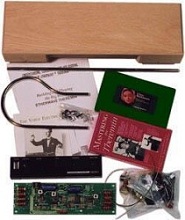
Olivia Mattis and Leon Theremin in Bourges, France - 1989
[This is a short excerpt from Mattis' interview, published with Robert
Moog as co-author: "Pulling Music Out of Thin Air," Keyboard, February,
1992, pp.46-54.]
Mattis:
Please tell me about your early life, and about your scientific and
musical training.
Theremin:
I was born in Leningrad, which was then called St. Petersburg, in 1896. My
father was a lawyer, and my mother was interested in the arts, especially
music and drawing. Even before high school I was interested in physics, in
electricity, and in oscillatory motions like those of a pendulum. In high
school I was interested in physics, and after playing the piano I started
studying cello. While in high school, I entered the Conservatory on the
cello, and I graduated with the title of "free artist on the violoncello."
Then I entered the university, and majored in physics and astronomy.
Mattis:
When did you first conceive of your instrument?
Theremin:
The idea first came to me right after our Revolution, at the beginning of
the Bolshevik state. I wanted to invent some kind of an instrument that
would not operate mechanically, as does the piano, or the cello and the
violin, whose bow movements can be compared to those of a saw. I conceived
of an instrument that would create sound without using any mechanical
energy, like the conductor of an orchestra.
Mattis:
Why did you make this instrument?
Theremin:
I became interested in bringing about progress in music, so that there
would be more musical resources. I was not satisfied with the mechanical
instruments in existence, of which there were many. They were all built
using elementary principles and were not physically well done. I was
interested in making a different kind of instrument. And I wanted, of
course, to make an apparatus that would be controlled in space, exploiting
electrical fields, and that would use little energy. Therefore I used
electronic technology to create a musical instrument that would provide
greater resources....
Mattis:
Edgard Varese came to you to ask you to build him an electronic cello. Do
you remember that?
Theremin:
I made my electronic cello, not only for Varese, but for all those who
were interested. It was not just the instrument played with hands in the
air. It was a different instrument, like a cello, that had a fingerboard.
But instead of pressing down on strings, it was necessary just to place
one's fingers in different places, thereby creating different pitches. I
have photographs of the instrument. It was also called the thereminvox.
There was one man who was very much interested in this instrument. He was
the conductor Leopold Stokowski, who had ordered instruments especially
for the Philadelphia Orchestra. I made ten instruments especially for
Stokowski. They used it in concerts, and it created a great impression....
Mattis:
Tell me about your dance instrument, the Terpsitone.
Theremin:
This is a platform that a person dances on. When the dancer's body is low,
you hear the lowest pitch. When the dancer raiser her body, the pitch also
goes up. It's also possible to dance without changing the sound. For
instance, if the dancer raises one arm and lowers the other, there will be
no change in pitch. But if the dancer raises both arms, then the pitch
will go up.
Mattis:
How about the loudness, the volume?
Theremin:
If the dancer goes more forward, it gets louder. When she steps back, the
sound gets quieter. I had a Terpsitone dance studio in New York. I had
many pupils dancing there.




